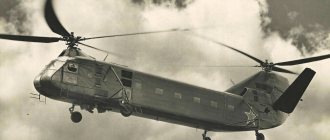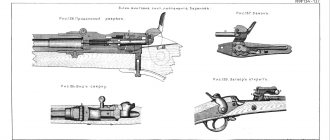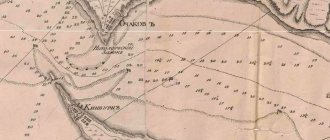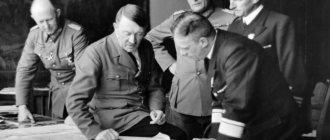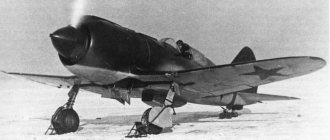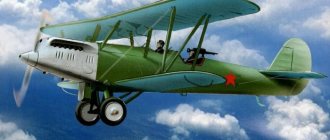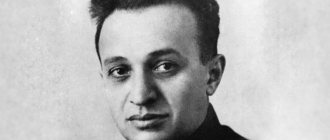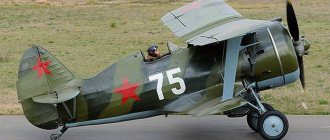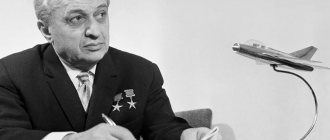From heaven to earth
Born in the Oryol region near the village of Georgievskoye (now Kalinino) in the Liven zemstvo on June 9, 1892 in a family of hereditary clergy. Mother was from a family of wealthy priests.
In her early years, his grandmother lived on the estate of I. S. Turgenev; her father, great-grandfather Kolya, according to evidence of that time, could serve as a prototype of the stern Bazarov from Turgenev’s work “Fathers and Sons.”
Nikolai's father was a participant in charitable events and organizations. He served in the rank of archbishop in several provinces. By 1903, the seventh child was born into the Polikarpov family.
Polikarpov family
| Sergei Gavrilovich and Maria Borisovna Arakin - grandfather and grandmother of Nikolai Polikarpov |
— Was Nikolai Nikolaevich’s father a priest?
- Yes, a hereditary priest. Once, in a conversation with his daughter, Nikolai Nikolaevich said: “We, the Polikarpovs, come from the Greeks.” There was such a legend in the family, perhaps erroneous. That's what it was based on. The history of the family goes back to the thirteenth century, when, according to the chronicles, the monk Polycarp “from the Greeks” came to Chernigov, to the Seversk land. He asked the prince for permission to baptize the Vyatichi who lived in dense forests in the Bryansk, Oryol, Tula, Kaluga and Lipetsk regions.
The prince gave several Russian priests to help the monk. One of them, who took as his surname the name of a teacher who was later canonized, gave rise to the Polikarpov family. After all, Polycarp himself was a monk and, therefore, could not have a family.
In the Oryol province, the Polikarpovs, together with their relatives, made up at least a quarter of the clergy, and had numerous relatives in neighboring dioceses. In the lists of graduates of the Oryol Theological School for 1790, you can read the name of the aircraft designer’s ancestor - Mikhail Polikarpov - and his brother Matvey. As regimental priest, Fr. Mikhail took part in the defeat of Napoleon's army. The family kept his award cross on the ribbon of the Order of St. Vladimir. On the front side was engraved the inscription: “Not to us, not to us, but to Your name,” and on the back was the date: “1812.” The Polikarpovs served Russia for centuries, Nikolai Nikolaevich simply continued this tradition.
— And if we talk directly about the parents of Nikolai Nikolaevich Polikarpov, how much is known about them?
— His mother Alexandra Sergeevna bore the surname Arakina as a girl. Her grandfather Boris Preobrazhensky became one of the prototypes of Bazarov, the hero of Turgenev’s novel “Fathers and Sons.” They had a long-term acquaintance with Turgenev. In his youth, Boris was a nihilist, but then he repented and took holy orders. During the cholera epidemic in the Oryol diocese, Fr. Boris Preobrazhensky went to confess to the dying, became infected and died. His daughter Maria, the grandmother of an aircraft designer, was raised in the Turgenev family after her father’s death. As a wedding gift, the writer gave her a silver casket, a silver mirror and necklace, an expensive Italian chest of drawers and a certain amount of money, which became the basis of the funds with which Maria Borisovna subsequently bought the estate.
Alexandra Sergeevna, Nikolai Nikolaevich’s mother, was well educated, according to the standards of that time. Father - Nikolai Petrovich - was, according to reviews, an excellent Orthodox teacher, for which he was awarded the Order of St. Anne, and was elected many times as a delegate to diocesan congresses. He served in the village of Georgievskoye near the city of Livny, Oryol region.
The atmosphere in the family was the most creative. It was an interesting combination. Father Nicholas and his sons, in addition to spiritual work, had to personally engage in peasant labor: breeding horses, mowing hay, plowing the land. But at the same time there was time for music and painting.
Censer or motor
Kolya Polikarpov’s childhood passed quickly; the boy loved to design and draw, and read a lot. At the age of 9 he was sent to study at the Livensky Theological School. At the age of fifteen he entered the seminary of the city of Orel. But fortunately N.N. Polikarpov was not interested in the boring life of a parish priest, but in the roar of engines and turbines; perhaps even then the sky beckoned him.
In 1911, having abandoned his spiritual studies and not thinking about his family vocation as a priest, he passed the exams and entered the St. Petersburg Polytechnic Institute.
Nikolai Polikarpov entered the mechanical department of the shipbuilding faculty. At the age of 20 (1912) he began his internship in Livensky district, working as an engineer in the construction of highways and bridges. At the age of 21, he became interested in aviation and attended relevant courses at the faculty, while simultaneously starting his studies at the second faculty of aviation.
At the age of 24 he defends his diploma “Marine Diesel 1000 hp.” and received the title “mechanical engineer of the 1st degree,” but failed to defend his diploma on a twin-engine aircraft.
At the time of entering the institute, Nikolai had six more brothers and sisters, and besides, tuition had to be paid. The father-priest's budget was limited. Therefore, the future aircraft designer, simultaneously with his training, worked as an assistant engineer in the workshops of the shipbuilding department of the plant, and later in the aircraft manufacturing department.
Links[edit]
- Aviation and astronautics. Publish militarily. 1973
- Smithsonian Air and Space Research. Smithsonian Institution Press. 1981. p. 83.
- Parrish, Michael (1996). The Lesser Terror: Soviet State Security, 1939-1953. Greenwood Publishing Group. paragraph 43. ISBN 9780275951139.
- Graff, Corey (2014). Flying Warbirds: An Illustrated Profile of a Rare World War II Aircraft from the Flying Legacy Collection. Voyageur Press. paragraph 51. ISBN 9780760346495.
- Davis, Robert William (1989). The Soviet Economy in Turmoil, 1929-1930. Harvard University Press. item 452. ISBN. 9780674826557.
- ↑
Associated Press, "Death of an Aviation Expert",
The San Bernardino Daily Sun
, San Bernardino, California, Tuesday, August 1, 1944, volume 50, page 2.
Bibliography[edit]
- Greenwood, John; Hardesty, Von; Higham, Robin (2014). Russian aviation and aviation in the twentieth century. Rutledge. ISBN 9781135251864.
- Ivanov, Vladimir (1995). Aircraft designer N.N. Polikarpov. St. Petersburg: Politekhnika. ISBN 5732500855. OCLC 34361460.
- Ivanov, Vladimir (2004). Aircraft N.N.
Polikarpova . Moscow: RUSAVIA. ISBN 5900078256. OCLC 70659422. - Maslov, Mikhail (2009). "King of Fighters"
Polikarpov combat aircraft . Moscow: Yauza. ISBN 9785699309986. OCLC 698862229. - Biography of Polikarpov on the website of the Russian Ministry of Defense
| Authoritative control |
|
The beginning and rise of a career
After his studies, he worked as a production manager at the Russo-Balta aviation department, which was the name of the multi-profile Russian-Baltic Carriage Plant at that time.
Nikolai’s leader and mentor was Igor Sikorsky, who drew attention to the talented student during his studies.
Polikarpov took part in the creation of the TB-3, a giant bomber, a revolutionary project at that time. He created projects for new fighters for the revived air units of the Workers' and Peasants' Red Fleet and at the same time was engaged in the modernization of old ones.
In 1918, the plant collapsed due to the difficult economic situation after the First World War and the revolution. I.I. Sikorsky did not find mutual understanding with the Bolsheviks in the new situation, and decided to emigrate. Not forgetting about his best student, he invited Polikarpov with him, promising better conditions for growth, but he refused.
Dedication to the Union
That same year, Nikolai began working in Moscow in the management of the Main Air Fleet, in one of the positions in the construction of aircraft factories. In 1918, he was sent to Moscow, to the Dux plant. As deputy head of the design department, he studied foreign aircraft and modernized domestic aircraft.
On his own initiative, with his team, he developed the first Soviet monoplane fighter. Serial production of the bold but unfinished IL-400 project was limited to 33 vehicles.
From 1924 to 1928 he changed several main leadership positions. During this time, he became the first Soviet person to develop methods for creating and testing aircraft. He streamlined the approach and science of aircraft construction, by which other designers were guided and aligned before the era of jet aviation.
In 1927, Nikolai Nikolaevich Polikarpov created a winged legend.
The U-2 training aircraft, weighing about 700 kg, was the desk of hundreds and thousands of pilots and for a long time won the reputation of the most successful and simple aircraft of the USSR. During its life, this aircraft has changed hundreds of guises: a training and communications aircraft, a limousine, a sprayer and a night bomber.
The machine, which trained about one hundred thousand pilots, was produced for a record long time - until 1954. This was facilitated by both the simplicity of the design and the low cost of the material: wood, canvas and plywood. In memory of him, the plane was renamed Po-2.
In February 1928, Polikarpov's design bureau moved to aircraft factory No. 25, where it completed the development of a new aircraft by September. The R-5 aircraft became one of the best all-purpose aircraft of the 30s.
An attack aircraft, a bomber, a carrier of chemical weapons, a reconnaissance aircraft and a transport aircraft, in whatever conditions it performed its tasks. One thing remained unchanged - high reliability and simplicity of design.
“We need to pray for them”
-Who told you the most about him?
- A little bit of each. In addition, in the 20s, transcripts of the meetings were constantly kept, there are a lot of them, and his speech is live there. There were a lot of denunciations.
-Who wrote them?
- Everyone wrote. It’s easier to say who didn’t write. For example, Ilyushin, Polikarpov’s best friend, did not write. Nikolai Nikolaevich made a number of projects for Ilyushin in gratitude, and Ilyushin’s early aircraft bear a strong imprint of Polikarpov’s design ideas. It was Ilyushin who at one time saved Nikolai Nikolaevich from Tupolev.
— Were Tupolev and Polikarpov enemies?
— The history of their relationship was quite complicated. Polikarpov is a designer from God, and Andrei Nikolaevich Tupolev is an outstanding organizer of the design business, but as an inventor he was not very strong.
Fate first brought them together during the First World War. Tupolev was the chief designer there, tried to create machines for naval aviation, but did not achieve much success - the sailors refused his aircraft. Then the director of the plant, Julius von Möller, who after the start of the war changed his inappropriate German surname to the sonorous Russian Brezhnev, called Tupolev and asked what was happening. He said that his team creates magnificent projects, and engineer Polikarpov does not bother to provide them with orders.
They called Polikarpov. “What are the projects, so are the orders,” Nikolai Nikolaevich answered calmly. Thus began their war with Tupolev, whom Meller kicked out of the factory.
Tupolev later wrote that he left, was offended and “took his drawings” (well, not exactly his own, a whole team prepared them). From that moment on, he did not miss the opportunity to trip Nikolai Nikolaevich. For the sake of business, as it seemed to Tupolev.
“It was a common occurrence back then.”
- Yes, but Polikarpov never acted like that. When Tupolev was arrested with a large group of his employees, Chkalov, joyful, ran to Nikolai Nikolaevich and announced: “Have you heard? They knocked down the oak!” (referring to the arrest of Tupolev, whom Chkalov did not like). And Polikarpov quietly said in response: “Yes, it’s hard for them now, we need to pray for them.”
— Did he help a lot of people?
— When his deputy Tomashevich was imprisoned, Polikarpov provided his family with money and food. After Dmitry Lyudvigovich’s release, he helped him get a job and, already dying, wrote letters to all authorities, to the People’s Commissariat, asking that his design bureau be given to Tomashevich.
And one day the NKVD received a denunciation against Yangel, then still a boy working for Polikarpov. Let me remind you that Yangel, along with Korolev, Chelomey and Glushko, is the father of Soviet cosmonautics and rocket science. So, he was accused of being the son of a kulak, and his father was hiding in the taiga. What would almost anyone do in Polikarpov’s place at a time when no one trusted anyone? And what did Polikarpov do? He gave the young employee leave and sent him to Siberia to collect documents about his father’s innocence.
Yangel himself was a man of a slightly different type. During the war, he left his family in evacuation without means of subsistence, leaving for Moscow. And one day, his wife Irina Strazheva later recalled, he and his children had neither bread nor money left. It's 1941. Suddenly there is a knock on the door. “I open it,” Irina said, “and there is a beast-like woman standing there, saying: “Polikarpov found out that your life is bad, he sent a bag of potatoes. Sign for receipt."
This is one of many stories. What can I say, a man with a capital M...
When our wonderful aircraft designer Grigorovich was dying, Polikarpov was the only colleague who visited him. They had a history when they were young. Both fell in love with the same girl, who worked, I don’t remember exactly, as a secretary or a typist at the Main Directorate of the Aviation Industry. The girl, Alexandra Fedorovna, chose Polikarpov, becoming his wife. Grigorovich was a noisy, harsh person and could shout at anyone, but not at Polikarpov. They retained respect for each other for the rest of their lives.
One step away from execution
On October 24, 1929, Nikolai Polikarpov was arrested by state security agencies, charging him with articles on counter-revolutionary activities and undermining industry. Nikolai's design errors and competition among aircraft manufacturers largely influenced the decision to arrest.
The political situation and the activation of the opposition aggravated the designer’s situation.
One of the opponents of the Soviet regime abroad was I.I. Sikorsky, Polikarpov’s former mentor, who proposed a plan to overthrow the government through an airborne assault from aircraft of his own production.
After waiting for two months, they decided to postpone the sentence indefinitely. He was saved by the need for talented aircraft designers in a difficult global situation.
In December, an aviation design bureau, the so-called “sharashka,” was created in the prison. Such bureaus at that time were the concentration of the scientific potential of the USSR. Polikarpov performed the duties of Deputy D.P. Grigorovich.
In 1930, several fighters were developed, including the I-5, which went on combat duty in the Air Force, where it served until the 40s. In the spring of 1930, Polikarpov had his charges reduced and sentenced to 10 years in a camp.
But everything changed in June 1931, when the I-5 was presented to the commission of the People's Commissariat of Defense and Armaments, headed by Stalin. The demonstration was successful and a month later Nikolai Nikolaevich was given amnesty along with other specialists, and his prison term was reclassified as suspended.
Conquering new heights before a serene sunset
After his release, Polikarpov moved to TsAGI. In 1933, the I-15 sesquiplane and I-16 monoplane were created within the framework of the concept of interaction between a maneuverable and high-speed fighter. The I-15 line was later developed in the form of the I-15-2 and I-15-3 fighters.
The I-16 also did not stand still and was constantly modernized; the last model of the I-16 type 29 was released in 1941. For this purpose, the best specialists and production facilities were gathered in our own design bureau.
The I-16 became one of the best cars to come out of Polikarpov's design bureau.
The frontal, maneuverable monoplane, assembled mostly from plywood, showed excellent results in China and Spain, where it was not inferior to the first modifications of its future enemy. To the planes of Willy Messerschmitt. This technique was used to set a world altitude record in 1935.
It was these vehicles that were the first to meet the enemy in the sky over Brest on June 22, 1941 and served until 1945. One of the last I-16s flew in Spain until the mid-50s!
In 1939, Nikolai Nikolaevich was sent to Germany. The task of the commission, which included Polikarpov, was to collect information about Luftwaffe aircraft and factories in Germany, which at that time was already considered a future enemy. While the aircraft designer was abroad, his design bureau was disbanded, specialists and projects were transferred to other designers.
So the project of Polikarpov’s high-altitude high-speed fighter was finalized and brought to series at the Mikoyan and Gurevich design bureau, it entered service as the MiG-1 fighter. Upon his return, Polikarpov put everything back together, while simultaneously working on other projects with a shortage of resources.
An old hangar without the necessary conditions for work was allocated as the site of the new design bureau.
At the beginning of the war, one of the best aircraft of its time was developed in this hangar, thanks to which the number of dead Soviet pilots could be reduced significantly. The I-185 with the M-71 engine was an order of magnitude superior in performance characteristics to all German aircraft. But the flawed design of the engine, to some extent, according to some historical data, Yakovlev’s intrigues, led to the oblivion of this fighter.
Although even with the M-82 engine, the I-185 was somewhat superior to its competitor La-5 in flight performance, not to mention armament, only the La-7 modification, produced in a small series at the end of the war, had 3 air cannons.
Nikolai Nikolaevich continued to lead the design bureau after doctors made a fatal diagnosis. Polikarpov's aircraft were in service for decades and were recognized as the best in their class on the world stage. By 1943 he had the highest state awards and two Stalin Prizes of the first degree. The outstanding figure died on July 30, 1944 from stomach cancer.
YANBERYAYKHI YUBKHYUNMYARPSYRNP, DNYRNP REUMKHVEYAYKHU MYUSY (1940), CHEPNI YANZHKHYUKHYARKHVEYAYNTSN rPSDU (1940). ON NYNMVYUMHH OERPNTSPUYUDYYNTSN ONKHREUMKHVEYAYNTSN KHMYARHRSRRYU X YSPYANB YUBKHYUZHKH OPH M╦L (1916) PUANRYUK MY PSYAYAYN-aYUKRKHIYAYNL BYUTSNMMMNL GYUBNDE, TsDE OND PSYNBNDYARBN L x.x. YAKHYNPYaINTSN SVYUYARBNBUK B ONYARPNIYE YYULNK╦RYU ╚xKE lSPNLEZH╩ X OPNEIRKHPPNBYUMXX HYARPEAHREKEY pubg. I 1918 PUANRYUK MU GYUBNDE ╚dSYA╩ (YUBKHYUGYUBND ╧1), TsDE DN 1923 Ts. PSYNBNDHK REUMHVEYAYHL NRDEKNL.| pHYA.1 hYARPEAHREKE x-1 |
BEYAMNI 1923 Ts. onKHYUPONBSHL ASHK YANGDYUM OEPBSHI YANBERYAYKHI HYARPEAHREKE x-1 (hk-400), YARYUBKHI OEPBSHL B LHP HYARPEAHREKEL - YABNANDNMEYASYHL LNMNOKYUMNL. b 1923 OND PSYNBNDYARBNL onKKHYUPONBU YANGDYUM KH PUGBEDVKHY p-1. b ЪМБУПЭ 1925 m.m.o. (ONYAKE NRZEGDYU d.o.tsPKHTSNPNBHVYU B kEMKHMTSPYUD) DNAHKYA NPTsYUMHGYUZHHH MU cyug 1 HL. YuBKHYUUHL NOSHRMNTSN NRDEKYU KH YARYUK ETSN MYUVYUKEMKHYNL. b TEBPYUKE 1926 Ts. b 1927 NM YANGDUER KHYARPEAHREKE x-3, B 1928 - PYUGBEDVKHY p-5 (ONKSVHK BHPNYYSCH KHGBEYARMNYARE B YABGKH YAN YAOYUYAEMHEL SHYAOEDHZHH OYUPNUNDU “VEKCHYAYHM”),
| pHYa.2 srya s-2(oN-2) |
YAYULNK╦R OEPBNMYUVYUKEMNTSN NASVEMKH s-2, ONKSVKHBHI BYAELHPMSCH KHGBEYARMNYARE KH OEPEHLEMNBYUMMNTSN B ON-2 ONYAKE YALEPRKH YNMYARPSYRNPYU). s-2 (оН-2) YARPNHKYA DN 1959 Ts. bN BPEL BEKKHYNI nREVEYARBEMMNI bNIMSH s-2 SYAOEMN OPHLEMKHYAE B YUVEYARBE PUGBEDVKHYNB, MNVMSHU ANLAYUPDHPNBYKHYNB. ONKKHYUPONB ASHK MENANYAMNBYUMMN PEOPEYAYAHPNBYUM. b NYRYAPE 1929 C. ETSN YUPEYARNBSHBUCHR ON YARYUMDYUPRMNLS NABHMEMHCH — “SVYUYARKHE B YNMRPPEBNKCHZHNMMNI BPEDHREKEYAYNI NPTSYUMHGYUZHHH” — X AEG YASDU OPKHTSNBUPHBUCHR Y BSHYAYEI LEPE MYYUGYUMH. ANKEE DBSU LEYAZHEB ONKKHYYUPONB MYUNDHKYA B NFKHDYUMKHH PUYAYARPEKYU. b DEYUAPE RNTsN FE TsNDYU (AEG NRLEMSH HKH KHGLEMEMKH OPHTSNBNPYU) ETSN MYuOPYUBKCHR B “nyANANE YNMYARPSYRNPYAYNE ACHPN” (zhya-39 tsos), NPTsYUMKHGNBUMMNE B aSRSHPYAYNI RCHPELE, YU GYUREL OEPEBEDEMMNE MU lNYAYNBAYKHI YUBHYUGYUBND N 39 HL. b.p.lemphhmyaintsn. where YANBLEYARMN I d.tsPKHTsNPNBHVEL B 1930 NM PYUGPYUANRYUK KHYARPEAHREKE x-5, YNRNPSHI MUUNDHKYA MU BNNPSFEMKHH 9 KER. b 1931 Ts.
| pCN. 3 hYARPEAHREKE x-153 |
MN ONYAKE SDYUVMNTSN ONYUGYU YARYUKHMS, bNPNHKNBS, nPDFNMHYKHDGE YAYULNKERYU x-5, OKHKNRKHPNBYUBYETSNYA vYUKNBSHL X yuMKHYAHLNBSHL, ASHKN PEYEMN YAVKHRYURE OPKHTSNBNP B NRMNYEMXX onKKHYUPONBU SYAKNBMSHL. b KhChKE RNTsN FE TsNDYu oPEGKHDHSL zhy yayap OPKHMЪK PEYEMKHE ON YULMKHYARKH TsPSOOSH KHJ, B RNL VHYAKE ONKHYUPONBU. RNKEIN B 1956 C. - VEPEG 12 KER ONYAKE YALEPRKH YNMYARPSYRNPU - bNEMMMYU YNKKETSKH BEPUNBMNTSN yasdyu yayayap NRLEMHKYU OPEFMEE PEEMHE yNKKETSKHH tsos X OPEYYURKHKYU DEKN B NRMN BEMXX onNKHYUPONBY. b 30-U CC. HL ASHKH YANGDUMSH HYARPEAHREKH x-15, x-16, x-153 “vYuYYU”, YANYARYUBKHBHE NYAMNBS YANBERYAYNI HYARPEAHREKEMNI YUBKHYUZHKH B OPEDBNEMMSHE TsNDSH. 21 MNAP 1935 Ts. MU x-15 KERVKHY b.y.yNYYHMYYKH SYARYUMNBKHK LHPNBNI PAINPD BSHYANRSH - 14575 YL. ONYAKE YUPEYARYU y.m.rSONKEBYU m.onKKHYYUPONB ASHK MYUGMYUVEM tsKYUBMSHL YNMYARPSYRNPNNL YUBKHYUGYUBNDU ╧ 156 (gny zhutskh). b MYUVYUKE ЪMBYUPЪ 1938 ECN ya OEPEEUUKN YACHDU I GUBNDU ╧84. y YNMZHS 1938 Ts. ASHK ONYARPNEM KHYARPEAHREKE x-180 - PUGBHRKHE x-16 I DBKHTSUREKEL l-87.;
| pHYA.4 hYARPEAHREKE x-16 |
MN TSHAEKE MU MEL b.o.vYUKNBU B OEPBNL FE HYAOSHRYUREKEMNL ONKERE BMNBE BBEPTSKN ONKHYUPONBU B NOYUKS. aSHKH YUPEYARNBYUMSH ETSN GULEYARKHREKE - BEDSYKHI YNMYARPSYRNP d.rNLYUBHV, DKHPEYRNP GYUBNDU ╧ 156 sYYUVEB X DP. YaYULNTsN ONKHYUPONBU NR YUPEYARYU YAOYUYAKN RNNKEIN RN, VRN NM NRYUGYUKYA ONDOKHYAYURE YUR TSNRNBMNYARKH YYULNKERYU Y OEPBNLS ONKERS H UNDYURYYARBN aYUIDSINBU. b LYUE 1939 PYUANRSH ON x-180 ASHKKH OEPEDYUMSH MU TsNYASDYUPYARBEMMNTSN YUBKHYUGYUBNDYU ╧ 1. YACHDU FE OEPEBEKKH H ya, Yu onKHYUPONB YARYUK REUMHVEYAYHL DHPEYRNPNL X TSKYUBMSHI YNMYARPSYRNPNNL GYUBNDU. oYUPYUKKEKEMN YAN YAYNPNYARMSHL x-180 oNKHYYUPONB OPNDNKFHK X KHMKHCH LYUMEBPEMMSHU AHOKYUMNB - x-190 (1939), x-195 (OPNEIR 1940). b 1939 Ts. oNKKHYUPONB BSHEUYUK B YNLYUMDKHPPNBYS B TsEPLYUMHCH. b ECN NRYASRYARBHE DKHPEYRNP GYUBNYU oYUBEK bNPNMHM X TsKYUBMSHI HMFEMEP oERP DELEMREEB (ASDSYKHI LHMKHYARP YUBKHYUZHNMMNI OPNLSHKEMNYARKH) BSDEKHKH KH YANYARYUBYU ya VYUYARE ONDPYU GDEKEMKHI X KSVIKHU YNMYARPSYRNPNNB (B RNL VHYAKE lHUYUHKYU TsSPEBKHVYU) X NPTsYUMKHGNBYUKH MNBSHI NOSHRMSHI YNMYARPSYRNPYAYKHI NRDEK, YU ON YSRKH - MNBNE ya, OND PSYNBNDYARBNL yuprel lhynymyu. GYUNDMN lHYNЪMS OEPEDYUKH OPNEIR MNBNTSN KHYARPEAHREK x-200 (ASDSYKHI lHts-1), YNRNPSHI ONKKHYUPONB MYUPYUBKHK B mYUPYNLUR YUBKHYUZHNMMNI OPNLSHKEMNYARH (myuo) MU SRBEPFDEMKHE OEPED YABNEI ONEGDYNI B tseplyumkhch. ONKKHYUPONB B YUVEYARBE SREEEMKH ONKSVKHK OPELKHCH GY OPNEIRKHPNBYUMKHE HYARPEAHREK x-200 KH...NYARYUKYAEG LMNTSKHU NOSHRMSHU YNMYARPSYRNPYAYKHU YUDPNB, AEG YANAYARBEMM SHU ONLEYEMKHI H, REL ANKEE, AEG OPNHGBNDYARBEMMNI AYUGSH. mu OEPBSHU ONPYU ETSN OPHCHRHK HYAOSHRYUREKEMSHI YUMTSYUP zhyutskh. GYUREL OND ONKHYUPONBU B YARYUPNL YUMTSYUPE MU NYPYUHME UNDSHMYH ASHK YANGDYUM MNBSHY TSNYASDYUPYARBEMMSHI GYUBND ╧ 51, ME BREAD MKHYUYNI YANAYARBEMMNI OPNHGBNDYARBEMMNI AYUGSH H DUFE GDIUMH DK PYUGLEYEMH ya. mu REPPHRNPHKH SHRNTSN GYUBNDYU B MUYARNYYEE BPEL MYUNDHRYA nya X NOSHRMSHY GYUBND HL. o.yaSUNTsN.
| pCN. 4 hYARPEAHREKE x-185 |
b 1938-44 onNKHYUPONB YAYNMYARPSKHPNBUK PJD NOSHRMSHU BNEMMSHU YAYULNK╦RNB: rhya, bhr, yaoa, ma X DP. 11 ЪМБУПЪ 1941 BGKEREK x-185 — OEPBSHI NREVEYARBEMMSHY HYARPEAHREKE ON RPEANBUMHOL 1940 Ts. b 1942 Ts. NM OPNYEK TSNYAHYAOSHRYUMKH BNIYAYNBSHE HYAOSHRYUMKH MY yUKHMHMYAYNL TPNMRE. ON NZHEMYE mxx bbya YAYULNKER OPEBNYAUNDHK BYAE NREVEYARBEMMSHE KH MELEZHYKHE YAEPHIMSHE KHYARPEAHREKH. MEDNBEDEMMNYARE DBKHTSUREK L-71, YURYUYARPNTYU, B YNRNPNI ONTSKHA KERVKHY-HYAOSHRYUREKE b.yu.YAREOYUMVNMNY, X NRYASRYARBHE GYUBNDU ME ONGBNKHKH GYUOSYARKHRE YAYULNKER B YaEPHCH . BNYPSTS ONKKHYUPONBU YAYKYUDSHBUKYUYAE MEGDNPNBU YURLNYATEPU. mYUVYUKYUYAE RPYUBK YNMYARPSYRNPYU, PYUANRSH RNPLNGHKHKYAE, ETSN NABKHMKKH B YNMYAEPBYURKHGLE. RYU OPNDNKFYUKNYAE DN 1942 Ts., YNTSDU YARYUKHM BGK ONKHYUPONBU OND YABNCH GYUYHRS. mN B 1944 C. ECN ME YARYUKN. nDMNI KH ONYAKEDMKHU ETSN PYUANR ASHK OPNEIR PUYERMNTSN KHYARPEAHREK "LYUKCHRYU". BYAETSN ONKKHYUPONBSHL ASHKN PYUGPYUANRYUMN YABSHYE 80 YYULNK╦RNB PUGKHVMSHU RHONB. gYu OEPHND 1923-1940 CC. MU GYUBNDE ╧ 1, MU REPPHRNPKHH YNRNPNTsN YAYEVYUYA PUGLEYYUERYA LYUHMNYARPNHREKEMSHI GYUBND HL. about. bNPNMHMYU, ASHKN ONYARPNEMN 15951 YAYULNKERNB (YU I VERNL LNDHTHYUZHHI NOSHRMSHU H ONYARPNEMMSHU MEANKEHLH YAEPHLH - 16698 LYUHM), B NYAMNBMNL, YNMYARPSYZHHH ONKKHYU PONBU. yaPEDH MKHU - YAYULNKERSH-PUGBEDVKHYKH p-1 (1914 YAYULNKERNB), p-5 (4548), RUYHE KHGBEYARMSHE HYARPEAHREKH, YUY x-3 (399 LYUHM), x-5 (803), x-15 (674 LYUKHMSH; YU BYAETSN - 3083), x-153 (3437), x-16 (MUUNDHKYAB YAEPKHIMNL OPNKHGBNDYARBE I 1934 OH 1941 TsTs.; BYAETSN ASHKN ONYARPNEMN 9450 LYUKHM), SVEAAMN-RPEMKHPPNBNVMSHY KHYARPEAHREK E srkh-4 (1639 LYUHM). MU YAYULNK╦RYUU ONKHYUPONBU YANBEPYEM PJD DUKEMKHU OEPEKERNB. ONKHYUPONB NDMHL XG OEPBSHU PYUYAVKEMHK OPNEIRKHPNBYUMKHE YYULNK╦RNB MU YAOEZHYUKHGKHPNBYUMMSHE VYUYARKH. ond PSYNBNDYARBNL onKKHYUPONBU PUANRYUKKH y.h.lKHYNJM, l.y.bMTSEKE, y.b.onRNNOYUKNB, b.y.rYUKHPNB, b.b.mHYHRKHM X DP. YAOEZHYUKHYARSH, YARYUBKHE BONYAKEDYARBKHH BHDMSHLH YNMYARPSYRNPYULH YUBKHYUZHNMMNI H PYYERMN-YNYALKHVEYAYNI REUMHYCH. I 1943 oNKHYUPONB - OPNTEYAYANP lyuh. DEOSRYUR byya yayap I 1937. TsNYASDYUPYARBEMMYU OPELHYayap (1941, 1943). MUTSPUFDEM 2 NPDEMYULH KEMKHMYU, NPDEMNL yPYUYAMNI gBEGDSH. oYURLRMHYH ONKHYUPONBS SYARYUMNBKEMSH B LNYAYBE, nPKE, kHBMYUU. b YAEKE yUKHMHME nPKNBYAYNI NAKYYARKH NRYPSHR LSGEE ONKKHYUPONBYU. ECN KHLEMEL MYUGBYUM OHI MU oYULHPE. 5 LYu 2000 Ts., B OPEDDBEPKHH dM ONAEDSH, MU REPPHRNPKHH ╚nya yaSUNTSN╩ ASHK RNPFEYARBEMMN NRYPSHR LELNPKHYUK, ONYABYEMMSHI mHYNKYUCH mHYNKYUEBHVS ONKHYUPONBS. MU YYYUCH MEANKENTSN OYUPYU, PJDNL I KHYARNPHVEYAYHL YUMTSYUPNL, B OYULRE ON SHRNL GYULEVYUREKEMNL YUBHYUNMYARPSYRNPE SYARYUMNBKEM ETSN ACHYAR H MEANKEYU YAREKYU YAN YAYPNL MSHL RPSFEMKHYNL BNIMSH, HYARPEAHREKEL x-153. ONYAKE YALEPRKH mKHYNKYU ONKKHYUPONBU B 1944 Ts. ETSN ya BNGTSKYUBHK bKYUDHLHP VEKNLEI, YNRNPSHY YAYNMZHEMRPHPNBUK SYAKHKH YNKKEIRKHBU MU PYUGPYUANRYE OEPBSHU B yayap YP SHKYURSHU PUYER I OSKEYAHPSCHYHLH BNGDSMN-PEYURHBMSHLH DBHTSUREKLH (YAYULNKERNB-YAMYUPDNB).
"onKHYUPONB m.m." (YARYURE XG FSPMYUKYU yushpnokyum 1993 ╧2) lMNTSHE XG OEPBNI OKEDSH YUBHYURNPNB, YNMYARPSYRNPNB, HMFEMEPNB, SVEMSHU, YNRNPSHE B MYUVYUKE BEYU OPKHKH B SCHRNR MNBSH AND YPSHKYURSHI LHP, BONYAKEDYARBKH YARYUKKH GMYULEMHRNYARLKH, NYARYUBKKKH N YAAE OYULRE. ON YAPYUBMEMHCH I DPSTSHLH BHDYULH VEKNKBEVEYAYNI DE'REKEMNYARKH YUBKHYUZHKH HER YANGDUREKH YANYARYUBKKKH RNMYKHI YAKNI. vRNASH ASHRE OPHVYYARMSHL Y MELS, MSFMYu ASHKYU HKKH ANKEYU SDYUVYU, KKH ANKENE FEKYUMKHE. with onKHYUPONBU ASHKN X RN X DPSTSNE. RYUY, OEPBSHI "RNKVNY" Y SBKEVEMHCH BNGDSUNOKYUBYUMHEL NM ONKSVKHK, YNTsDU SVHKYAB DSUNBMNI YAELHMYUPHH! ONBEGKN H I "PYYAOPEDEKEMHEL": ONYAKE NYNMVYUMH oEREPASPTSYAYNTSN SMHBEPAHRRYU MUOPYUBHKH MU pubg Y h.h.yaHYNPYYNLS b DBYUJURSHU TSNDYUU onKKHYUPONB YARYUMNBHRYA GYULERMNI THTSSPNI B YUBHYUOPNLE, GYU VRN, MYUBEPMNE, KH ASHK NOPEDEKEM tsos B RCHPELMNE zhya-39. YANGDUB B RCHPELE BLEYARE I DPSTSHLH RYUYHLH FE GYULERMSHLH "GYULEVEMMSHLH" YNMYARPSYRNPYULH X HMFEMEPYULH PJD GYULEVYUREKEMSHU YAYULNKERNB, NM YARYUK ONVRKH EDHMYARBEMMSHL "ONYARU" BYKHYNL" KHYARPEAHREKEY DKYANBERYAYKHU bbya. Yayap ЪBХКЯЪ MUYAKEDMKHYNL KHLOEPHH X OEPEMK NR MEE X RUYNE ЪBKEMKHE, YUY TYUBNPHRKHGL. b YUBKHYUZHKH, MUOPHLEP, TYUBNPHRNL PSYNBNDYARBU LNTs YARYURE YNMYARPSYRNP, KERVKHY KH DUFE YAYULNKER. oNLMHRE ShchRS YARYUKHMYAYSCH "SYARYUMNBYS": "xK-2 MSFMSH MYUL YUY BNGDSU", - GMYuVHR DPSTSKHE, YaS-6 MUOPHLEP, MH Y VELS. onKKHYUPONBU ONDMJKKH DBYU TYUBNPKHRYU - KERVKHY vYUKNB X YAYULNKER x-16. x-16 OPHMEYA ONKKHYUPONBS GBYUMKHE “YNPNK KHYARPEAHREKEY.” vYYUKNB ONLNTs B YAYULSHE YPSRSHE TsNDSH NYARYUREYAY MU YABNANDE. I RYYNI YUMYERNI KH ONYAKE "UNKNDMNTSN DSUE" NR Bf-109 B hYAOYUMHKH, NYARSDKHBIETSN BNYARNPTSKH ON ONBNDS x-16, ONKHYUPONBS ASHKYU NDMY DNPNTSYU - DUFE ME B MNBSC RCHPELMSCH "YUPYUTS" S", Yu B KYUTSEP. oNRNL ONTSHA vYYUKNB, S PSYNBNDYARBU ONJBHKHYAE MNBSH TYUBNPHRSH X KCHAHLZHSH - LNKNDSHE YUBKHYUNMYARPSYRNPSH, PNDYARBEMMKHYH VKEMNB zhi, ONRNL MYVYUKYUYAE BNIMYU X YARYUKN ME DN YNMYSPYANB MU KSVIKHI YAYULNKER. x BYAE SHRN YNTSDU WITH ONKKHYUPONBU MYYNOKEM NOSHR, PNFDUCHRYA MNBSHE KHDEH. YYUYHE YPYYYAKHBSHE X LNYMSHE YYULNKERSH ONEBKCHRYA S METSN B YANPNNYNBSHE TsNDSH - x-185, rkhya, bhr, hro, ma. mu TsNKNBS BSHYE YNMYSPEMRNB. KERVKHYKH DUCHR NRKKHVMSHE NRGSHBSH ON TPNMRNBSHL HYAOSHRYUMKHIL x-185. “OPEIPYYAMN! - TsNBNPIR "MYUBEPUS". - oSYARE onKHYUPONB OPEDYUYAR BYACH DNYSLEMRYUZHCH ON YABNELS YYULNKERS kYUBNVIHMS. with AEDMTSKH VRN-RN ME KHDER ETSN kYu-5″. oNRNL GYUAPYUKH GYUBND H ya. DUFE MUDEFDSH ME NYARYUBHKH. nYARYUKNYAE RNAEIN SLEPERE. fYUKE, VRN ME BYAE XG GYUDSLUMMNTSN SYAOEK YADEKYURE SHRNR RYUKYUMRKHBSHI VEKNBEY. MN OYULRE N mHYNKYUE mHYNKYUEBHVE ONKKHYUPONBE FKHBER B YAEPJUU BYAEU HYARHMMSHU SHMRSGKHYUYARNB YUBHYUZHHH.
